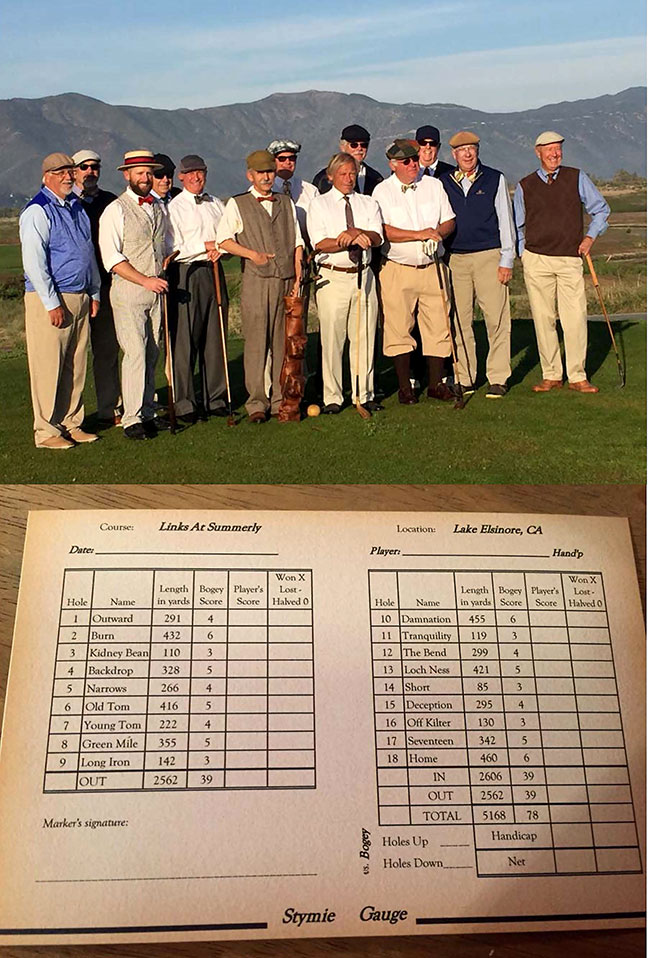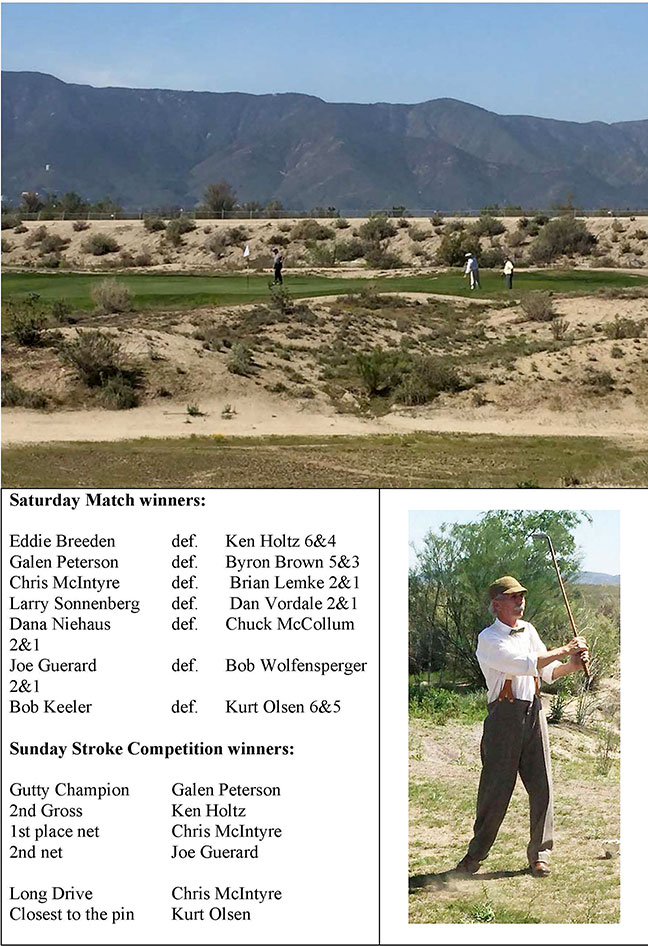This weekend, March 19-20, we played in the Pacific Hickory Golfers’ Gutty Spectacular event in Southern California at the Links of Summerly in Lake Elsinore, Calif. (For results of the tournament and photos, please scroll down.)
We’ve played the course often the past few years in small group outings, both 1920s hickory and gutty era. The course is an open course layout at the southeast end of Lake Elsinore. It features wasteland, bunkers, and a burn that runs through a number of holes. It used to be bermuda grass that would go dormant in the winter, but the course ran into hard times and was shut down for nine months last year. The new ownership is trying to get the fairways back in shape and, thankfully, the greens were not destroyed. Matter of fact they are in great shape and have a fair amount of roll and interest to them. Right now the fairways are in harsh condition. New grass was started last fall, but this spring and sSummer will be their best chance to rebound. Unfortunately for us, they will not be bermuda. I really enjoyed the dormant, firm winter conditions for gutty play.
That all being said, it was a tough track for our gutty event. Tough for anyone who expects pristine play conditions, and a challenge to accept and relish in the opportunity to play golf as in the early era and some of the possibilities of irregular terrain. Remember, this is the game that produced rut irons (for hitting out of wagon ruts or ditches), and they did not rake bunkers. They played it as it laid.
I think the thing to take away from the event from the aspect of play is that it was a chance to experience some of how it really might have been for older amateur golfers playing gutty golf in the 1880-90s. It was hard! All the names we read about from those early days, the scores they posted, and the championships they won, were all about young skilled golfers of the day. They were professionals and they honed their games by being on or around the course every day for years. The equipment they used was top notch and progressive for the day. It is difficult to compare our capabilities. I, for one, am well aware that I am not the physical specimen that I once was. My entire life, though, I’ve been able to hit the ball relatively far given my not so large or strong stature. There has always been a class above me that could hit it longer and play better.
We played the course at 5,168 yards. Troon in 1888 was 5,656 yards, Dornoch was 5,285 yards, Machrihanish was 5,552, Carnoustie was 5,617 yards, North Berwick was 4,851 yards. St Andrews was similar in yardage; my estimate is about 5,400 yards. These were all large links layouts with open play, not small homegrown courses like our beloved Oakhurst in West Virginia.
Such are this game’s demands that, even at your best, when you strike the ball solidly, you will still be hitting many long shots to reach the green. Achieving a 150-yard carry approach over a burn that guards the front of a green makes you feel like you’ve conquered a mountain. Our longest drive hole (landing in the fairway) was won this day at 152 yards (mostly carry as it did not run out on the dilapidated fairway). Not bad for a 140-pound, 62-year old man. But, known fact, that could have been surpassed by a younger player with the right match of club and shaft flex and a straight flight. With the right trajectory and some run we’ve seen about 185 yards.
That leads us to the stories written of the leading professional players of the early era.
There were stories of young Tommy Morris hitting a 225-yard approach shot to a long hole, and other prodigious recollections of 300-yard drives, etc. How did they do it? If you can imagine the sound, feel, and awe of watching a modern day player, or a 1970s professional, playing persimmon and hitting balata, or even Nelson or Snea you realize that that’s on a different level. I have to think these top young players of the auld era were something of a different level as well.
So, if a hole is 320 yards and you feel today that it is impossible to reach in two shots, it probably was as well for a guy like you in 1880. Like him, this is the place to put forth your best and take what you can get. Mark it down on the scorecard as a 7 and move on to the next challenge. It might be a high number, a number you may not be used to, but go ahead and total it up. There were high numbers for everyone this weekend.
There was a glimmer of hope for everyone, but usually it was a failed short game or simply a lack of distance that added to the tallies. Good scores were certainly possible, as Eddie Breeden demonstrated by carding a score during the match play that was 10 shots below the next lowest score of the weekend. By the way, he is our 35-year-old player, and still a hobbyist and amateur.
The entire Gutty Specatular was played with the true (synthetic) replica gutty golf ball that is available for these events, and not the older, rubbery version from Oakhurst or the newer limited flight version that is available.
For all the positive features the gutty ball provides, there is still the task of finding the right clubs and especially the playclub that will hit well and hold up to the historical harshness of the gutty. We had discussions after the rounds about how great it would be to have a ball that didn’t ruin the clubs, and I must note that this was a problem in the early era as well. I believe we should maintain the gutty ball’s authentic features, and that maybe our concession could be with the club face. We were using clubs that have demonstrated resilience, and/or have leather faces either original or replaced. What if we chose to upgrade the leather face style of repair with a fiber or plastic face? Being the auld golf proponent that I am, I’ve realized that sayting true to “perfectly authentic” is a tough challenge. But this move to face replacements of modern materials, I think, would be less of a variance to the game than a ball change, and could make a lot of players happier to be spending money on these specialty clubs.
As for the style of play, I still enjoy the Match Play portion of the event the best. Yes, there were stroke play championships, but there is something very beneficial of the bond between two players grinding it out with hope on every new hole…lots of good times to be had with this format. AGS Play Rules were in use for the weekend.
When it comes down to it, though, everyone loves a chance to be crowned the champion and we need to continue to play both styles of play.


Chris “Auld Mac” McIntyre, at right, above, is a staunch proponent for golf of the 1890s – and earlier – both with equipment and in clothing style. McIntyre was the originator of the modern replica gutty ball.
